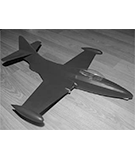 Random image Random image |
 |

GRUMMAN F9F-5 PANTHER
nitrocharged
|
 |
|
 |
 |
STILETTO
| STILETTO |
| Description: |
Reprinted from Model Aircraft, May 1954 (p. 184)
A contest model for the Jetex 200 by one of the experts
STILETTO is the latest in a line of models designed for the Jetex 200, and developed from the original Firecrest, which won the first I.C.I. Challenge Trophy contest in 1949 with a 20 : 1 ratio.
Stiletto Since then the tendency has been towards lighter construction, reduced wing area, and smaller fuselage cross-section: so that the biggest asset of present-day Jetex models is a steep, fast climb. Stiletto belongs to this school of thought, and must be trimmed accordingly. It is able to stay in a fast straight climb, and will gain maximum height in this way. High-thrustline is the ideal set-up for this trim, while under-slung jet units generally characterise the " spiral-climb " type of model.
The original model was lost after an 8-minute flight (on one pellet). It had previously qualified for the I.C.I. Finals with 3 : 55 o.0.s. on 14 secs. fizz (ratio 16 : 8). The second Stiletto built gained fourth place in the 1953 I.C.I. Trophy, with a ratio of 9 : 07; and anyone who attended the All-Britain Rally can remember that weather conditions were not ideal.
It is of vital importance to go easy when trimming, starting with only 4-5 sec. of fizz. If the least tendency to turn under power is apparent, do not fail to make a correction before the next attempt. Anyone who has flown contest Jetex models (or only watched them) knows that they are even more prone to spiral power dives than prop-powered planes. With reaction propulsion, variations of thrust are common, and such variations will cause inconsistencies in airspeed fatal to a circling model. Moral: keep straight! Then it will be safe to say "the faster the better" … and the resulting climb will certainly satisfy you.
Fuselage
The fuselage section takes the form of an inverted triangle: i.e. the "base" is at the top, and the "apex" forms a keel at the bottom. The fuselage is built upside-down, the "base" being built first, on the plan. (See fuselage top elevation.) After the spacers have set, the first five inches of this are curved upwards, till the point of the nose is 11/16 in. from the building-board. Now the formers can be added, and the underfin also, after the 3/32 in. keel has been cemented in place.
After the fuselage has been lifted from the plan, add pylon centre-post, cementing it firmly to the keel. Then pylon front and rear edges can be added, and top also. Eventually all spacers can be added, and Jetex mounting clip screwed into place. Check that thrust-line is as shown on plan. Note: If the builder has not had too much experience with Jetex models, it is recommended to build the pylon unit separately, and make it "knock-off" in the event of a power dive. However, if you consider yourself able to trim without such diversions, it is well worthwhile to make the pylon integral with the fuselage, as this will be lighter. Add small fin as d/t stop, and 1/8 in. sheet to give correct tailplane incidence as shown – add also 1 mm. ply platform for tailplane.
Cover with lightweight Modelspan, and add two coats of clear dope. Total weight should be 0.4 oz.
Wings
These must be constructed with care, as weight has to be cut to a minimum. Ensure that T.E. is of hard 1/16 in. sheet. Build whole wing on plan, leaving out top spar and bracing struts at first. All "oblique" ribs are of 1/32 in. sheet, while "straight" ones are of 1/16 in. sheet.
Tips only have dihedral, so these are cracked up to the required angle. Be careful not to let the dihedral "creep" to a greater amount than that shown on the plan: more than ¼ in. extra could be dangerous to performance. When dihedral has set, add top spar and forward bracing struts. Give wing adequate time to set firmly, having ensured … of course … that the building-board is dead flat. Cover with light Modelspan, add two coats of clear dope on top, one coat below. Check dihedral does not change, nor warps appear, while dope is drying. Same applies to tail. Wing weight 0.4 oz.
Tail
This is built on plan, dihedralled as shown. Add pins as shown, for operation of tip-up d/t. Cover with light Modelspan, one coat of dope top and bottom. Weight 0.2 oz. |
| Keywords: |
stiletto jetex 200 dick twomey |
| Date: |
04.01.2021 22:45 |
| Hits: |
4143 |
| Downloads: |
5 |
| Rating: |
0.00 (0 Vote(s)) |
| File size: |
46.6 KB |
| Added by: |
nitrocharged |
|
|
 |
